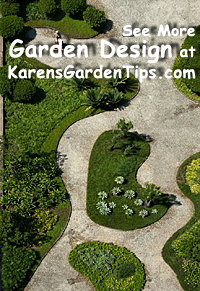
The characteristics of a formal garden go back to classical times as developed by the artists of the Renaissance. Control and creating order were guiding forces in the development of the style and it became popular with monarchs and other powerful men. Even today it is associated with status and wealth.
Formal gardens in the Western tradition are characterized by:
 Bilateral symmetry; one side of the garden is the mirror image of the other. Hardscape, plant material, and shape of the garden beds are similar on either side of an axis so that the appearance of perfect balance is created. If there is tall tree on one side of the garden, there will be a similar tree in the same position on the other side of the garden.
Bilateral symmetry; one side of the garden is the mirror image of the other. Hardscape, plant material, and shape of the garden beds are similar on either side of an axis so that the appearance of perfect balance is created. If there is tall tree on one side of the garden, there will be a similar tree in the same position on the other side of the garden.
 Dominant hardscape with walls, paths, terraces, pools and similar elements creating a strong structure and year-round attractiveness.
Dominant hardscape with walls, paths, terraces, pools and similar elements creating a strong structure and year-round attractiveness.
 Perfect proportions with hedges, paths, flower beds, walls, and other garden features in proportion to each other to create a restful, peaceful, enduring ambiance that emphasizes a control over the natural environment.
Perfect proportions with hedges, paths, flower beds, walls, and other garden features in proportion to each other to create a restful, peaceful, enduring ambiance that emphasizes a control over the natural environment.
 Repetition of hardscape elements and plant material to provide rhythm and strong balance.
Repetition of hardscape elements and plant material to provide rhythm and strong balance.
 Geometric shapes with strong emphasis on right angles and rectangular forms.
Geometric shapes with strong emphasis on right angles and rectangular forms.
 Straight paths.
Straight paths.
 Man-made level topography.
Man-made level topography.
 Clipped shrubs, hedges, and lawn with everything appearing to be in its place and under complete control.
Clipped shrubs, hedges, and lawn with everything appearing to be in its place and under complete control.
 Classical garden ornaments such as statuary, urns, and topiary.
Classical garden ornaments such as statuary, urns, and topiary.
 Surrounded by a visual barrier such as a wall, clipped hedge or dramatic elevation change of the ground to give it a clear separation from the surrounding natural landscape.
Surrounded by a visual barrier such as a wall, clipped hedge or dramatic elevation change of the ground to give it a clear separation from the surrounding natural landscape.
 Although formal gardens evolved as prerogative of the rich and powerful, they can be very attractive on a smaller scale in modest gardens. You don’t need twenty beds, hundreds of feet of hedge, a ten foot tall wall, or thousands of plants to create a very pleasant formal retreat. A simple patio with a couple of identical beds and planters could create “the look”. Some people think that formal gardens are very expensive to install or maintain; they can be but they don’t have to be. Grow vines on a trellis to create a wall, grow plants like Alberta spruce that have naturally handsome shape to substitute for topiary. Good looking urns are available at the big box stores but terra cotta pots can be just as effective. Create matching beds with annuals bought in 6 packs. A successful formal garden can be created using inexpensive materials and plants in a way that reflects the characteristics of the formal gardens of bygone eras.
Although formal gardens evolved as prerogative of the rich and powerful, they can be very attractive on a smaller scale in modest gardens. You don’t need twenty beds, hundreds of feet of hedge, a ten foot tall wall, or thousands of plants to create a very pleasant formal retreat. A simple patio with a couple of identical beds and planters could create “the look”. Some people think that formal gardens are very expensive to install or maintain; they can be but they don’t have to be. Grow vines on a trellis to create a wall, grow plants like Alberta spruce that have naturally handsome shape to substitute for topiary. Good looking urns are available at the big box stores but terra cotta pots can be just as effective. Create matching beds with annuals bought in 6 packs. A successful formal garden can be created using inexpensive materials and plants in a way that reflects the characteristics of the formal gardens of bygone eras.